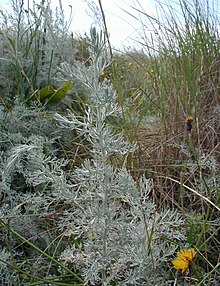Artemisia maritima
| Artemisia maritima | |
|---|---|
 |
|
| Scientific classification | |
| Kingdom: | Plantae |
| (unranked): | Angiosperms |
| (unranked): | Eudicots |
| (unranked): | Asterids |
| Order: | Asterales |
| Family: | Asteraceae |
| Genus: | Artemisia |
| Species: | A. maritima |
| Binomial name | |
|
Artemisia maritima L. 1753 not Ledeb. 1833 nor L. ex Hook.f. 1891 nor Kitag. 1939 |
|
| Synonyms | |
|
|
Artemisia maritima is a European species of wormwood known as sea wormwood and old woman. It is native to France, the United Kingdom, Italy, Belgium, Germany, Denmark, Sweden, Bulgaria and Russia.
In its many variations of form it has an extremely wide distribution in the northern hemisphere of the Old World, occurring mostly in saltish soils. It is found in the salt marshes of the British Isles, on the coasts of the Baltic, of France and the Mediterranean, and on saline soils in Hungary; thence it extends eastwards, covering immense tracts in Southern Russia, the region of the Caspian Sea and Central Siberia to Chinese Mongolia. In Britain it is found as far as Wigton on the West and Aberdeen on the East; also in north-east Ireland and in the Channel Islands. It can be also found in Italy, on the Northern Adriatic coast.
The plant somewhat resembles Artemisia absinthium, the absinthe wormwood, but is smaller. The stems rise about a foot or 18 inches in height. The leaves are twice pinnatifid, with narrow, linear segments, and, like the whole plant, are covered on both sides with a coat of white cottony fibers. The small, oblong flower heads, each containing three to six tubular florets, are of a yellowish or brownish tint; they are produced in August and September, and are arranged in racemes, sometimes drooping, sometimes erect.
...
Wikipedia
